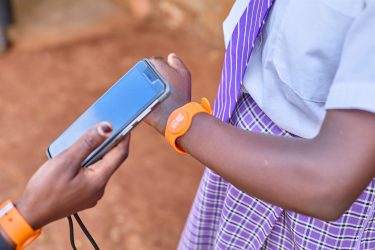Food4Education’s scalable hunger relief solution transforming African classrooms
Posted: 28 May 2025 | Ben Cornwell | No comments yet
On World Hunger Day, this instalment of Ingredients for Change champions the simple yet groundbreaking strategy for feeding school children daily, as part of durable public infrastructure. New Food spoke with Wairimu Nyandia to learn how a social enterprise in Kenya has transformed lives.
Every school day in Kenya, more than 500,000 children line up for a hot, nutritious meals — a simple meal that fuels their learning to brighten their futures. Behind these meals lies an efficient system: centralised and decentralised kitchens prepare the food, trucks and motorbikes deliver it across cities and rural areas, and dedicated teams ensure every child gets fed. This is no handout or fleeting act of charity. It is a locally engineered, sustainable solution designed to tackle one of Africa’s most persistent challenges: classroom hunger.
Hunger is not just about lack of food, it’s about access and equity…
Food4Education, an award-winning Kenyan-led social enterprise founded in 2012 by Wawira Njiru, is redefining what it means to feed children at scale.
What began as a humble effort serving just 25 students has grown into a powerhouse that has delivered over 100 million meals to date. But beyond these impressive numbers lies a deeper ambition: to prove that school feeding programmes can be a permanent, efficient and scalable pillar of public infrastructure.
What sets the organisation apart is its determined focus on systemic change, viewing hunger not as an issue of scarcity, but of design. “Hunger is not just about lack of food,” says Wairimu Nyandia, Food4Education’s Chief Operations Officer, “it’s about access and equity.”
Released on World Hunger Day (28 May 2025), this story unfolds against a stark global backdrop.
According to the 2024 UN Food Security report, up to 757 million people faced hunger globally in 2023, including one in five in Africa. Meanwhile, 2024 was the warmest year in the global temperature record, which dates back to 1850 (NOAA 2024).
Yet, in a world marked by deepening inequality and climate disruption, Food4Education is showing what is possible when hunger relief is designed as infrastructure, not charity.
A model built for scale and context
A unique feature of Food4Education is its commitment to cost-effective, replicable blueprints. Meals are provided for just $0.30 each, thanks to a carefully engineered four-part model: local sourcing, centralised storage, innovative cooking and smart logistics.
This model is not theoretical — it is mobilised daily. A 35,000-square-foot warehouse stores up to six months’ worth of staple produce, allowing the team to buy in bulk and bypass seasonal price fluctuations. From there, food is prepared overnight in industrial kitchens and delivered via a mapped distribution network.


Credit: Food4Education
Adaptability is central to Food4Education’s approach. During Kenya’s rainy season in October 2022, washed-out roads made one school inaccessible.
Nyandia explains, “We wouldn’t have been able to access the school the following day with the car that we were driving in because the roads were washed off. At the time, we had to think very fast because we couldn’t come back and tell the kids or the school management that we would not be able to provide meals there because the roads had been washed off.”
This challenge led them to reassess how their model operates across different contexts. In Nairobi, meals are distributed by large trucks, while in more remote counties motorbikes are used to navigate difficult terrain.
“It’s not a one shoe fits all. The model that works in Nairobi might be tweaked a little bit to be able to fit contexts of a different region,” Nyandia notes.
The meal contents also vary based on local produce, with some schools for example served kale and others cabbage. This adaptable model allows Food4Education to meet diverse community needs, helping to support its expansion across Africa.
Tangible impact in the classroom
The effect on education has been profound. Attendance at partner schools has increased by up to 10 percent, enrolment by 27 percent and national exam performance by 20 percent.
Nyandia offers a compelling example: “There’s a seventh grader named Eunice Wangari. Before Food4Education, she used to carry food from home in the morning. By the time it got to lunchtime, that food was already cold… now she doesn’t have to worry, she just needs to leave home with her Tap2Eat Bracelet and know that she will definitely be able to get an affordable, hot, nutritious meal.”
Teachers also report major improvements. According to Nyandia, one headteacher, Mr Mburu Peter Njoroge, used to worry whether students would return after lunch at all; many would go home to eat, and those who lived far away often came back late, if at all. Even when they returned, hunger and fatigue made it difficult for them to concentrate, affecting their academic performance.
Now, with meals served at school, students stay on-site, eat together and return to class focused and ready to learn.
Every efficiency gained lowers the cost per meal
At the heart of Food4Education’s success is a deep commitment to data-informed operations, driven by the belief that every efficiency gained lowers the cost per meal for families.


Food4Education’s Tap2Eat Bracelet. Credit: Food4Education
A cornerstone of this system is Tap2Eat, a tech-enabled wristband linked to each child’s digital wallet. Parents can load funds easily, and when students arrive for lunch, they simply tap their wristband to receive a meal.
This seamless process not only collects payment but also verifies that the meal is delivered to the right child.
Behind the scenes, Tap2Eat feeds real-time data into operational dashboards, providing full visibility of meal uptake, delivery timing and kitchen output. This transparency cuts food waste to nearly zero and supports smarter planning by combining live data with historical trends and predictive analytics.
This ensures efficiency and dependable data for planning their next step: multiple country expansion.
From Doer to Enabler
By 2030, Food4Education aims to feed 1 million children daily in Kenya and 2 million children daily across at least two other African countries — not by running operations themselves but by enabling governments and local partners to adopt their blueprint.
“What we want to be able to do is build an ecosystem,” Nyandia says. “A Centre of Excellence where people can learn how to locally source, use data and sustainably feed children in different contexts.”
Governments, NGOs and institutions would be trained not only in meal production but in finance, procurement, logistics and policy alignment.
This handoff, from direct provider to systems enabler, reflects Food4Education’s broader philosophy. Hunger relief should be part of a long-term, locally rooted infrastructure, not an externally funded patchwork. “It’s not just about charity. It’s about creating and building equitable systems that make economic sense.”
Nyandia illustrates this sound concept thus: “A kid in Kenya will be in school for just below 200 days. If you tell them, you will only be able to have resources for 100 days, then what happens during the other days that they’re in school?”
This is where the organisation draws a line. Feeding children on some days but not others is not good enough. What is needed is consistency, predictability and equity.
A scalable African solution
Food4Education’s blueprint offers a compelling counterpoint to the global food crisis — a vision of school meals not as emergency relief but as essential infrastructure. And it proves this can be achieved efficiently, affordably and locally, even under the pressures of climate change, market instability and limited public budgets.
With its eye firmly on sustainability and scale, Food4Education is poised to shift not just how meals are delivered, but how societies understand their value.
“Every child deserves access to a nutritious meal,” Nyandia says. “And as such, we need to have the resources to be able to sustainably do that.”
On World Hunger Day, that message could not be more timely.
Enjoying the series? Why not read the previous instalment in Ingredients for Change series, which highlights Kitt Medical’s mission to put life-saving adrenaline within reach.
Reach out!
As part of our Ingredients for Change series, we are always on the lookout for the next wave of innovators and unsung heroes making a difference in the food industry.
If you know of individuals, companies, or initiatives advancing food safety, pushing for regulatory change, or transforming other aspects of the industry, we’d love to hear from you.
Contact our Assistant Editor Ben Cornwell ([email protected]) with your suggestions and help us spotlight the voices and solutions shaping the future of food!









